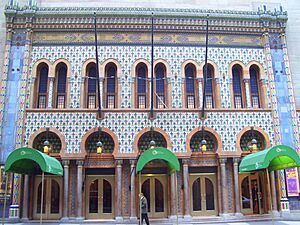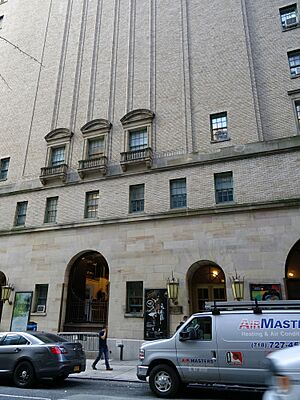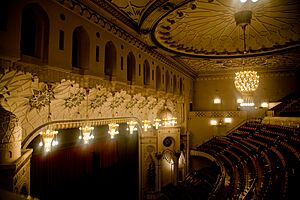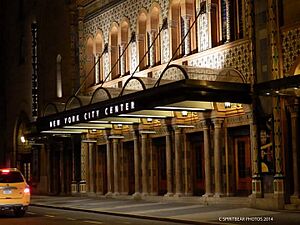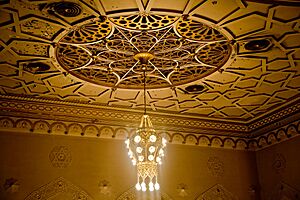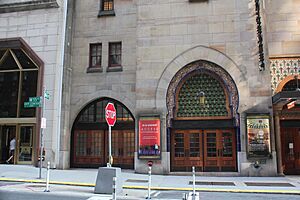New York City Center facts for kids
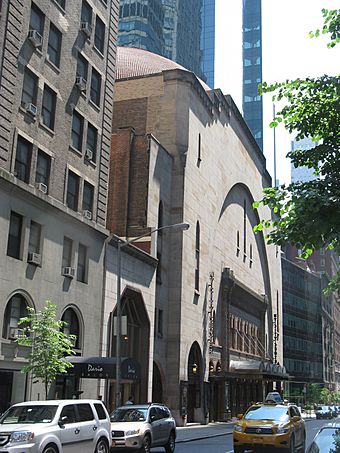
New York City Center in 2010
|
|
| Address | 131 W. 55th St. New York, New York United States |
|---|---|
| Owner | City of New York |
| Operator | City Center 55th Street Theater Foundation |
| Type | Performing arts center Off-Broadway (MTC) |
| Capacity | Main stage: 2,257 Stage I: 299 Stage II: 150 |
| Construction | |
| Opened | 1924 (building) 1984 (Stages I & II) |
| Years active | 1943–present |
| Architect | Harry P. Knowles and Clinton & Russell |
|
Mecca Temple
|
|
| Area | less than one acre |
| Architectural style | Moorish |
| NRHP reference No. | 84002788 |
| Significant dates | |
| Added to NRHP | September 7, 1984 |
The New York City Center is a famous performing arts center in Midtown Manhattan, New York City. It is located at 131 West 55th Street. It was first built between 1922 and 1924 by a group called the Shriners. They used it as a meeting place.
Since 1943, the building has been a performing arts complex. It is owned by the government of New York City. Today, City Center is a main stage for many dance companies. It also hosts the Manhattan Theatre Club (MTC). Every year, it presents the Encores! musical theater series and the Fall for Dance Festival.
The building was designed by Harry P. Knowles and Clinton and Russell. It has a unique Moorish Revival style. The southern part of the building has a main auditorium with 2,257 seats. Below this main stage are two smaller theaters. One of these is used by the MTC. The building also features a beautiful sandstone front and a large dome. The northern part of the building is simpler. It has rehearsal studios and offices.
The Shriners built the center because their old headquarters was too small. It opened on December 29, 1924. During the Great Depression in the 1930s, the Shriners had to leave the building. In 1943, New York City mayor Fiorello La Guardia helped turn it into a public performing arts venue. It reopened on December 11, 1943.
In its early years, City Center was home to the New York City Opera and New York City Ballet. It also hosted symphony, dance, and drama groups. In the 1960s, the opera and ballet companies moved to Lincoln Center. The City Center continued to operate until 1976. Then, the City Center 55th Street Theater Foundation took over. Since the 1980s, City Center has mostly hosted dance shows. It also started hosting off-Broadway plays when the MTC moved in. The building has been renovated several times, including in the 1980s and 2010s.
Contents
About the Building
New York City Center is located on West 55th Street in Midtown Manhattan. It is between Sixth and Seventh Avenues. The building is L-shaped. It extends north to 56th Street. The area around City Center has historically been a center for artists. Many buildings nearby were built for artists and musicians.
When the Mecca Temple was built in 1923, the area had garages, stables, and a school. The southern part of the site was once a movie studio. The northern part had horse stables.
Design and Style
The New York City Center was built by the Shriners as the Mecca Temple. It was a Masonic place of worship. Architects Harry P. Knowles and Clinton and Russell designed the building. Its style is called Neo-Moorish. Some people have described it as "Moresco-Baroque" or "delightfully absurd."
The building has a strong steel frame. Its roof is held up by a very large steel beam. This beam was one of the biggest pieces of steel ever used in a New York City building at the time.
Outside Look
The City Center building has many designs inspired by Islamic architecture. The building is split into two main parts. The northern part is taller and narrower. It holds clubrooms and meeting rooms. The southern part is wider and faces 55th Street. This part has the auditorium and banquet hall. It also has a dome on its roof.
55th Street Entrance
The southern part of the building, where the theater is, is covered in golden sandstone. It has a huge pointed arch that covers most of the front. The word "Mecca" was originally written at the top of this arch. The 55th Street side also has colorful glazed terracotta tiles. A glass and steel canopy was added above the entrance in the early 2010s.
The main entrance has an alfiz with nine horseshoe arches. These arches are surrounded by colorful terracotta designs. Each arch is supported by granite columns. They have colorful tiles inside, some showing a scimitar and a crescent moon. Metal lamps hang within the arches. The design of the entrance matches the staircases and lobby inside. The five middle arches lead to the main lobby. The arches on the sides lead to staircases for the balconies.
Domed Roof
The theater's dome is about 104 feet (32 meters) wide and 50 feet (15 meters) tall. It is covered with 28,475 Spanish roof tiles. This dome was designed as a true sphere. The tiles are made by Ludowici Roof Tile and come in shades of red and orange. They get narrower towards the top of the dome. This makes City Center the only building in the Northeastern United States with a dome like this. The top of the dome used to have a scimitar and a crescent. The roof was repaired in 2005.
56th Street Side
The 56th Street side of City Center looks very different from the 55th Street side. This part of the building was built for a different purpose. The ground level is made of limestone and has five arches. The upper 11 stories are covered in yellow brick. They have fewer windows because they used to hold the Shriners' private rooms.
Inside the Building
The Mecca Temple originally had a large auditorium that could hold 5,000 people. It also had a banquet room in the basement for 5,000 people. Three lodge rooms on the upper floors could fit another 3,000 people. By 2010, the building had offices, a main auditorium with 2,753 seats, two smaller auditoriums in the basement, and four studios.
The main doors on 55th Street lead to the ticket lobby. Gold metal doors lead into the main auditorium. In 2011, the lobbies were changed so people enter the auditorium from the sides. The lobby now has a bar and screens for video art.
Main Auditorium
The main auditorium originally held over 4,000 people. These seats were on a ground floor and two steep balconies. The balconies are supported by strong beams. The second balcony, also called the gallery, hangs over the first balcony.
Over the years, the number of seats was reduced. In 1982, 186 seats were removed, making it 2,746 seats. The front rows were also raised to improve views. In 2011, the seating was reduced again to about 2,250 seats. Six rows were removed, the slope of the floor was increased, and seats were made wider and reupholstered in blue and green.
The stage arch and ceiling were decorated in an Islamic style. They had designs like stalactites and honeycombs. The auditorium also had Moorish designs like stars and chandeliers. When the city took over in 1943, the space was repainted white. In 2011, the original colors were brought back.
The original design of the auditorium made it hard to see the stage from some seats. The stage was also small, without much space on the sides for performers. This made it difficult for some types of shows. The building had a special air system to remove smoke, as the Shriners often smoked during meetings.
Basement Theaters
The basement was originally a large banquet hall. It had no columns, supported by strong trusses that also held up the auditorium floor.
In 1981, the basement became a 299-seat off-Broadway theater called The Space. The Manhattan Theatre Club (MTC) moved into the basement in 1984. They divided it into two smaller theaters. As of 2022, MTC runs Stage I (299 seats) and Stage II (150 seats) in the basement.
Offices and Studios
The three lodge rooms in the northern part of the building became rehearsal studios. In the 1950s, writers for the TV show Your Show of Shows worked in one of the offices. Today, the theater's rehearsal studios are on the upper floors.
History of City Center
Mecca Temple Era
The City Center building was first built as the Mecca Temple for the Shriners. Their previous headquarters was on 45th Street. By the early 1920s, they needed a bigger space. In 1921, 1,500 Shriners voted to build a new temple. They raised money by selling bonds. In 1921 and 1922, they bought the land on 55th and 56th Streets.
Construction plans were filed in August 1922. The building was designed to have a meeting hall, a three-level auditorium, and offices. The auditorium was meant to hold 5,000 seats so it could be rented out for concerts. The building was officially opened on December 29, 1924.
Shriners' Use and Challenges
The Mecca Temple's auditorium opened to the public in May 1925. It hosted fashion shows and concerts. The New York Symphony Orchestra moved its performances there. Unlike other Shriners temples, this one was not tax-exempt because it made money from renting out its space.
By the 1930s, the Great Depression made it hard for groups like the Shriners to keep up their activities. The Shriners struggled to make mortgage payments. In 1937, the bank took over the building. Different companies tried to run it, but none made a profit. By 1940, the Shriners had stopped using the building completely. It was mostly used for political speeches and small events.
In 1941, a man named Max Rabinoff planned to turn the auditorium into the Cosmopolitan Opera House. He wanted to use it for ballet, opera, and concerts. The theater reopened in November 1941. It hosted shows like the NBC Symphony Orchestra and operettas.
City Center of Music and Drama
In 1942, the New York City government bought the building for $100,000. Mayor Fiorello La Guardia and New York City Council president Newbold Morris planned to turn it into a public theater. They wanted to offer "cultural entertainment at popular prices," with tickets as low as $1.
In July 1943, the City Center of Music and Drama (CCMD) was created. La Guardia and Morris appointed a board to run it. The city hired Aymar Embury II to renovate the auditorium. The building was officially renamed City Center. The CCMD began paying rent in October 1943.
Opening and Early Success
City Center opened on December 11, 1943, with a concert by the New York Philharmonic. The first play was Susan and God. City Center initially showed popular Broadway revivals. Famous performers like Helen Hayes and Orson Welles appeared there.
The new New York City Opera started performing in February 1944. The New York City Symphony Orchestra also debuted there. The first shows were profitable, even with low ticket prices. By May 1944, the theater had made over $414,000. This success led to plans for their own ballet and theater companies.
The Ballet Russe de Monte-Carlo performed at City Center for five years starting in 1944. In 1948, George Balanchine and Lincoln Kirstein's Ballet Society became the New York City Ballet Company. City Center remained popular in the late 1940s.
Financial Challenges and Changes
By the 1950s, City Center faced financial issues. Production costs were rising. In 1953, a law was passed allowing the CCMD to lease the building for only $1 per year. The Rockefeller Foundation also donated money to support the ballet and opera companies. A visual art gallery opened in the building in 1953.
The CCMD continued to lose money, despite high attendance. In 1955, the Board of Estimate officially leased the building to the CCMD for $1 per year. Donations helped cover many of the costs.
Ballet and Opera Move Out
By 1959, the CCMD considered moving its shows to the new Lincoln Center. In 1961, City Center closed its art gallery because it was not making money. In 1964, the City Ballet announced it would move to the New York State Theater at Lincoln Center. By its 20th anniversary in 1963, City Center had welcomed 16 million guests.
In 1965, the CCMD decided to permanently move its ballet and opera companies to Lincoln Center. The CCMD became part of Lincoln Center. They continued to host light opera and drama at the 55th Street theater.
Plans for the 55th Street Theater
The CCMD continued to support the 55th Street theater. In 1966, the Robert Joffrey Ballet became a resident dance company there. The city government gave $500,000 for renovations in 1967. This money was used to fix the air conditioning and repaint the inside.
In the early 1970s, the CCMD considered demolishing the 55th Street theater. They wanted to build a new skyscraper with a larger theater. However, they decided to keep the existing building in 1975. By then, the 55th Street theater mostly hosted dance performances.
55th Street Theater Foundation Takes Over
In May 1975, City Center was reorganized. Separate boards were created for the City Ballet, City Opera, and the 55th Street theater. The CCMD focused on its Lincoln Center operations.
In August 1976, the City Center 55th Street Theater Foundation took over the 55th Street theater. This foundation was led by several ballet companies. The building continued to be used mainly for dance performances. It became known as "America's premier dance theatre." In 1978, a new stage was installed. By 1980, the foundation was making a profit.
1980s Renovations and Changes
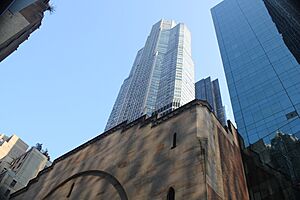
In 1981, the basement was turned into a 299-seat off-Broadway theater. In 1982, the foundation received a grant to renovate the theater. The renovation cost $900,000. It improved views from the seats, expanded the lobby, and restored decorations. The refurbished theater reopened in October 1982.
The Manhattan Theatre Club moved into City Center's basement in 1984. That same year, City Center was named a city landmark. A developer named Ian Bruce Eichner wanted to buy City Center's "air rights" for his nearby CitySpire skyscraper. This would give him more space for his building. In exchange, he agreed to make improvements to City Center. However, he did not complete these improvements, leading to legal disputes.
City Center continued to host ballet and dance shows. In the late 1980s, they also considered producing musicals. In 1990, part of the auditorium was closed for restoration.
Daykin's Leadership
Judith Daykin became City Center's executive director in 1991. The Joffrey Ballet stopped performing there regularly due to money issues. When Daykin took over in 1992, the theater only hosted shows for 17 weeks a year. Within a year, she paid off the center's debt. She also started the Encores! Great American Musicals in Concert series in 1994. This program presented rarely heard musicals. Daykin helped turn City Center from a rental hall into a place that produced its own shows.
By the late 1990s, the Encores! series was very popular. City Center also continued to host dance companies. It started a dance-education program for middle school students. In 1999, the building needed more repairs, including fixing the leaky dome. A new chairman, Raymond A. Lamontagne, planned to create a fund for the center.
By 2000, the theater was hosting shows 40 weeks a year. City Center had a budget of $10 million and many staff members. However, production costs were rising. This made it harder for some dance companies to afford to perform there.
Shuler's Leadership and Renovation
In 2003, former Joffrey Ballet dancer Arlene Shuler became president and CEO. She renamed the venue New York City Center. She also started the Fall for Dance Festival, which sold dance tickets for only $10. This attracted new audiences and dance companies. In 2005, City Center repaired its leaky roof.
A major renovation of City Center began in March 2010. It cost $75 million. The work included better views from seats, new seating, and a new canopy. Historical parts of the building were also restored. The renovation was finished in October 2011. Mayor Michael Bloomberg led a ceremony to reopen the theater.
After the renovation, the Alvin Ailey Dance Theater became City Center's main dance company. However, some other dance companies left because the stage was still too small for their needs. City Center temporarily closed in March 2020 due to the COVID-19 pandemic in New York City. Its popular Encores! series was paused for two years. The Fall for Dance Festival was held online in 2020. In 2021, Arlene Shuler resigned. Michael S. Rosenberg became the new director in September 2022.
Management and Programs
City Center of Music and Drama Inc.
The 55th Street theater was first managed by the City Center of Music and Drama Inc. (CCMD). This organization was created by the city government in 1943. The CCMD was also the parent company of the New York City Ballet and the former New York City Opera. For its first 20 years, the CCMD mostly operated only at the 55th Street theater. In 1965, the CCMD became part of Lincoln Center.
Many of the CCMD's original groups are no longer connected to City Center or no longer exist. For example, the New York City Symphony and the New York City Dance Theater only performed there for a few seasons. The City Center Art Gallery operated from 1953 to 1961.
55th Street Theater Foundation
The City Center 55th Street Theater Foundation took over the 55th Street theater in August 1976. This foundation rents out the main auditorium to different performers. It also leases the basement space to the Manhattan Theatre Club.
New York City Center Inc. is a nonprofit organization that controls the theater. As of 2023, Michael S. Rosenberg is the president and CEO.
What's On Stage
In 2018, The New York Times described City Center as a place for artists in theater, dance, and music. From the 1940s to the 1960s, it hosted opera, symphony, drama, dance, and ballet companies. Since the late 20th century, City Center has hosted many dance performances each season. It also hosts the Fall for Dance Festival and Encores!.
Dance
In 2004, New York City Center started the yearly Fall for Dance Festival. This festival attracted many young people and those new to dance. The theater also hosts events like the New York City version of the Vail International Dance Festival.
The New York City Center Choreography Fellowship helps new choreographers. It gives them money, rehearsal space, and support.
Theatre
New York City Center launched its first Encores! Great American Musicals in Concert shows in 1994. Encores! presents musicals that are rarely performed. The program has won many awards, including a Tony Honors for Excellence in Theatre award in 2000. The New York Times called Encores! a "major guardian of America's musical-theater heritage." Many Encores! productions have moved to Broadway, like After Midnight and Gypsy.
Encores! Off-Center started in 2013. It focuses on rarely heard off-Broadway musicals. City Center also partners with Jazz at Lincoln Center for special shows.
Past Programs
The Elinor Morgenthau Players and Playwrights Workshop opened in 1951. It was located on three floors of the City Center building. This workshop helped new playwrights create and present their plays.
In 1970, City Center helped sponsor "Cinémathèque at the Metropolitan Museum." This showed 70 films from the first 75 years of movies. This led to plans for a City Center Cinematheque, but it never formally opened.
See also
 In Spanish: New York City Center para niños
In Spanish: New York City Center para niños


